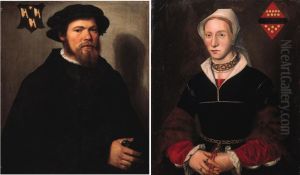Jan Jacobsz. Doudijn Paintings
Jan Jacobsz. Doudijn was a Dutch painter who was born in The Hague in 1630. His artistic career unfolded during the Dutch Golden Age, a period in which Dutch art, science, trade, and military were among the most acclaimed in the world. Doudijn was primarily known for his landscape paintings, which often depicted the flat, lush countryside of the Netherlands, characterized by precise attention to atmospheric effects and a delicate handling of light and color.
Doudijn was trained in The Hague and became a member of the Guild of Saint Luke, which was the typical organization for painters of the time. He was part of a community of artists who contributed to the rich cultural landscape of the era, which included figures like Rembrandt, Vermeer, and Hals. Although not as widely known as these contemporaries, Doudijn’s works were appreciated for their serene and pastoral quality. His landscapes often included waterways, with small figures and boats that provided a sense of scale and human presence within the expansive natural scenes.
Details about Doudijn's personal life are scarce, as is the case with many artists from this period. It is known that he worked in The Hague throughout his career and that his paintings were sought after by collectors in the region. The appeal of his work lay in its ability to capture the tranquil and ordered aspects of Dutch life, reflecting the values of harmony and prosperity that were central to the country's identity during the 17th century.
Doudijn passed away in 1680, in The Hague. His legacy is preserved through the paintings that survive him, which continue to be studied and appreciated for their contribution to the Dutch landscape tradition. While he may not have achieved the fame of the Dutch Golden Age's most prominent masters, Jan Jacobsz. Doudijn remains a respected figure in the history of Dutch art, with his works serving as a window into the serene beauty of the Netherlands during one of its most flourishing periods.
